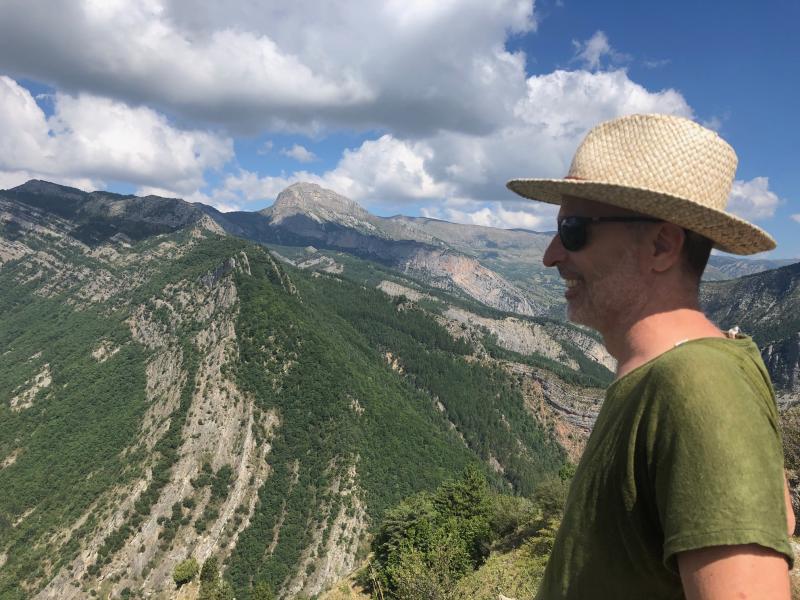Selection of publications. For a more complete list see my HAL online CV or my Google Scholar profile
Allard, D. (2025) Growth of spatial statistics for agriculture and environment: the example of BioSP at INRAE. Spatial Statistics, 70,
100938. https://doi.org/10.1016/j.spasta.2025.100938
Jacquemin G., Allard D., Freulon X., Vrac M. (2025) Return period of non-concurrent climate compound events: a non parametric bivariate Generalized Pareto approach. https://hal.science/hal-05045625/
Allard D., Benoit L., Obakrim S. (2025) Modeling and simulating spatio-temporal, multivariate and nonstationary Gaussian Random Fields: a Gaussian mixtures perspective. https://hal.inrae.fr/hal-05034982v1
Organ E., Upton M., Allard D., Benoit L., Sweeney J. (2025) Enhancing the Accuracy of Spatio-Temporal Models for Wind Speed Prediction by Incorporating Bias-Corrected Crowdsourced Data. arXiv:2505.24506
Obakrim S., Benoit L., Allard D. (2025) A multivariate and space-time stochastic weather generator using a latent Gaussian framework. Stochastic Environmental Research and Risk Assessment, 39, 3677–3701 https://doi.org/10.1007/s00477-024-02897-8
Allard D., François, B., García de Cortázar-Atauri, I. and Vrac, M. (2025) Assessing multivariate bias corrections of climate simulations on various impact models under climate change. Hydrology and Earth System Sciences 29 (18), 4711-4738 https://doi.org/10.5194/hess-29-4711-2025 https://hal.inrae.fr/hal-04227826
Castel-Clavera J., Pimont F., Opitz T., Ruffault J., Barbero R., Allard D., Dupuy J.L., (2025) A comparative analysis of fire-weather indices for enhanced fire activity prediction with probabilistic approaches, Agricultural and Forest Meteorology, 361, 110315, https://doi.org/10.1016/j.agrformet.2024.110315
Bonneu F., Makowski, D., Joly J. and Allard D. (2024) Machine learning based on functional principal component analysis to quantify the effects of the main drivers of wheat yields. European Journal of Agronomy 159, 127254. https://doi.org/10.1016/j.eja.2024.127254
Vrac, M., Allard, D., Mariethoz G., Thao, S. and Schmutz, L. (2024) Distribution-based pooling for combination and multi-model bias correction of climate simulations. Earth System Dynamics: https://doi.org/10.5194/esd-15-735-2024
Clarotto, L. Allard, D., Romary, T., Desassis N. (2024) The SPDE approach for spatio-temporal datasets with advection and diffusion. Spatial Statistics, 62, 100847 https://doi.org/10.1016/j.spasta.2024.100847 Preprint available at arXiv preprint 2208.14015
Pereira, M., Desassis, N., Allard D., Geostatistics for Large Datasets on Riemannian Manifolds: A Matrix-Free Approach, (2022) J. data sci. 20, no. 4, 512-532, DOI 10.6339/22-JDS1075. Preprint available at arXiv 2208.14015
Allard, D., Clarotto, L. & Emery, X. (2022) Fully nonseparable Gneiting covariance functions for multivariate space-time data. Spatial Statistics, 52, 100706.https://doi.org/10.1016/j.spasta.2022.100706. Preprint available at https://hal.archives-ouvertes.fr/hal-03564931/
Allard, D. Hristopulos, D.T., Opitz T. (2021) Linking physics and spatial statistics: A new family of Boltzmann-Gibbs random fields.
Electron. J. Statist. 15(2): 4085-4116
DOI: 10.1214/21-EJS1879
Carrizo Vergara R., Allard, D., Desassis, N. (2021) A general framework for SPDE-based stationary random field. Bernoulli, 28(1): 1-32. DOI: 10.3150/20-BEJ131. Preprint: arXiv:1806.04999
Opitz T., Allard D., Mariethoz G. (2021) Semi-parametric resampling with extremes. Spatial Statistics, 42: 100445, doi.org/10.1016/j.spasta.2020.100445
Soubeyrand S., Ribaud M., Baudrot V., Allard D., Pommeret D., Roques L. (2020) COVID-19 mortality dynamics: The future modelled as a (mixture of) past(s) PLOS-One 15(9) doi.org/10.1371/journal.pone.0238410
Allard, D. Emery X., Lacaux, C., Lantuéjoul, C. (2020) Simulating space-time random fields with nonseparable Gneiting-type covariance functions. Statistics and Computing, 30(5): 1479-1495, doi:10.1007/s11222-020-09956-4. Preprint: arXiv: 1912.02026
François B., Vrac M., Cannon A.J., Robin Y., Allard D. (2020) Multivariate bias corrections of climate simulations: Which benefits for which losses? Earths System Dynamics, 11, 537–562.
Tallieu, C. Badeau, V., Allard, D., Nageleisen, L.M., Bréda, N. (2020) Year-to-year crown condition poorly contributes to ring width variations of beech trees in French ICP level I network, Forest Ecology and Management, doi.org/10.1016/j.foreco.2020.118071
Soma M., Pimont F., Allard D., Fournier R., Dupuy, J.-L. (2020) Mitigating occlusion effects in LAD estimates from Terrestrial LiDAR through a specific kriging method. Remote Sensing of Environment 245-111836. doi.org/10.1016/j.rse.2020.111836
Cuevas, F., Porcu, E., Allard, D. (2020) Fast and exact simulation of isotropic Gaussian random fields defined on the sphere cross time. Statistics an Computing, 30(1), 187-194. doi.org/10.1007/s11222-019-09873-1 arXiv:1807.04145
Pimont, F., Allard, D., Soma M. Dupuy, J-L (2018) Estimators and confidence intervals for plant area density at voxel scale with T-LiDAR. Remote Sensing of Environment, 215, 343-370. doi.org/10.1016/j.rse.2018.06.024
Benoit L., Allard D., Mariethoz, G. (2018) Stochastic Rainfall Modelling at Sub‐Kilometer Scale. Water Resources Research, 54, 6, 4108-4130 doi.org/10.1029/2018WR022817
Marcotte, D. and Allard, D. (2018) Gibbs sampling on large lattice with GMRF. Computers and Geosciences, 111, 190-199. doi:10.1016/j.cageo.2017.11.012.
Allard, D. and Marchant, T. (2018) Means and covariance functions for spatial compositional data: an axiomatic approach, Mathematical Geosciences, 50(3), 299-315; doi: 10.1007/s11004-017-9713-y. Manuscript accessible here.
with RESSTE network (2017). Analyzing spatio-temporal data with R: Everything you always wanted to know - but were afraid to ask. Journal de la Société Française de Statistique, 158(3), 124-158. Supplementary material is here
Csilléry, K., Kunstler G., Courbaud, B., Allard, D., Lassegues, P., Haslinger, K., Gardiner, G. Coupled effects of wind-storms and drought on tree mortality across 115 forest stands from the Western Alps and the Jura mountains, Global Change Biology 23(12) 5092-5107. DOI : 10.1111/gcb.13773
Marcotte, D. and Allard, D. (2017) Half-tapering strategy for conditional simulation with large datasets, Stochastic Environmental Research and Risk Assessment, 32(1), 279-294. doi: 10.1007/s00477-017-1386-z. Manuscript accessible here.
Bourotte M., Allard, D. and Porcu, E. (2016) A Flexible Class of Non-separable Cross-Covariance Functions for Multivariate Space-Time Data, Spatial Statistics, 18(A), 125-146. doi: 10.1016/j.spasta.2016.02.004. (manusript: ArXiv 1510.07840)
Zaytsev, V. BIver, P., Wackernagel, H. and Allard, D. (2016) Change-of-Support Models on Irregular Grids for Geostatistical Simulation, Mathematical Geosciences, 48(4): 353-369. doi: 10.1007/s11004-015-9614-x.
Allard, D. Senoussi, R., Porcu, E. (2016) Anisotropy models for spatial data. Mathematical Geosciences, 48(3): 305-328. doi: 10.1007/s11004-015-9594-x. Preprint accessible here.
Ailliot P., Allard, D., Monbet V. and Naveau, P. (2015) Stochastic weather generators: an overview of weather type models. Journal de la Société Française de Statistiques, 156(1), 101-103. Paper accessible here.
Allard, D., Bourotte, M. (2015) Disaggregating daily precipitations into hourly values with a transformed censored latent Gaussian process. Stochastic Environmental Research and Risk Assesment, 29(2), 453-462, doi: 10.1007/s00477-014-0913-4. Preprint accessible here.
Allard, D., Lopez-Lozano, R. and Baret, F. (2013) Modeling forest canopies with a hierarchical multi-ring Boolean model for estimating Leaf Area Index. Spatial Statistics, 5, 42-56. doi:10.1016/j.spasta.2013.04.007. Preprint accessible here.
Renard, P. and Allard, D. (2013) Connectivity metrics for subsurface flow and transport. Advances in Water Resources, 51, 168-196. doi:10.1016/j.advwatres.2011.12.001 Preprint accesstible here.
Girard, R. and Allard, D. (2013) Spatio-temporal propagation of wind power prediction errors. Wind Energy,16, 999-1012. doi:10.1002/we.1527
Allard, D. Soubeyrand, S. (2012) Skew-normality for climatic data and dispersal models for plant epidemiology: when application fields drive spatial statistics. Spatial Statistics, 1, 50-64. doi: 10.1016/j.spasta.2012.03.001. Preprint accessible here.
Allard, D., Communian, A. and Renard, P. (2012) Probability aggregation methods in geoscience. Mathematical Geosciences, 44: 545-581. doi: 10.1007/s11004-012-9396-3. Preprint accessible here.
Allard, D. (2012) Modeling spatial and spatio-temporal non Gaussian processes. In Space-Time Processes and Challenges Related to Environmental Problem,
Eds. Porcu, E., Montero, J.-M. and Schlather M., Lecture Notes in Statistics, Vol. 207, Springer. pp. 141-164. doi: 10.1007/978-3-642-17086-7_7
Allard, D., D'Or, D. and Froidevaux, R. (2011) Letter to the Editor: Response to W. Li and C. Zhang,
European Journal of Soil Science, 63, 125-128. doi: 10.1111/j.1365-2389.2011.01414.x. Preprint accessible here.
Allard, D., D'Or, D. and Froidevaux, R. (2011) An efficient maximum entropy approach for categorical variable prediction, European Journal of Soil Science, 61, 381-293. doi:10.1111/j.1365-2389.2011.01362.x. preprint accessible here.
Flecher, C. Allard, D. and Naveau P. (2010) Truncated skew-normal distributions: moments, estimation by weighted moments and application to climatic data.Metron - International Journal of Statistics -- Special Issue on Skew-symmetric and flexible distributions, LXVIII, 331-345. Prepint is accessible here.
Flecher, C., Naveau P., Allard D. and Brisson, N. (2010) A Stochastic Daily Weather Generator for Skewed Data, Water Resource Research, W07519. doi:10.1029/2009WR008098. Preprint accessible here.
Gabriel, E., Allard, D. and Bacro, J.-N. (2010) Estimating and testing zones of abrupt change for spatial data, Statistics and Computing, 21, 107-120. doi:10.1007/s11222-009-9151-x. Preprint accessible here.
Flecher, C., Naveau, Ph. and Allard, D. (2009) Estimating the Closed Skew-Normal distributions parameters using weighted moments", Statistics and Probability Letters, 79, 1977-1984. doi:10.1016/j.spl.2009.06.004. Preprint accessible here.
Bel, L., Allard, D., Laurent, J.M., Cheddadi, R. and Bar-Hen, A. (2009) CART algorithm for spatial data: Application to environmental and ecological data, Computational Statistics and Data Analysis, 53, 3082-3093. doi:10.1016/j.csda.2008.09.012. Preprint accessible here.
Garrigues, S., Allard, D., Baret, F. Modeling Temporal Changes in Surface Spatial Heterogeneity over an Agricultural site (2008) Remote Sensing of Environment, 112, 588-602. doi:10.1016/j.rse.2007.05.014.
Gabriel, E. and Allard, D. Evaluating the Sampling Pattern When Detecting Zones of Abrupt Change (2008) Environmental and Ecological Statistics, 15, 469-489. doi:10.1007/s10651-007-0067-3. Manuscrit accessible ici.
Gabriel, E., Allard, D., Mary, B. & Guérif, M. (2007) Detecting zones of abrupt change in soil data, with an application to an agricultural field. European Journal of Soil Science, 58, 1273-1284. doi:10.1111/j.1365-2389.2007.00920.x.
Garrigues, S., Allard, D., Baret, F. & Morisette, J. (2007) Multivariate Quantification of Landscape Spatial Heterogeneity using Variogram Models. Remote Sensing of Environment, 112, 216-230. doi:10.1016/j.rse.2007.04.017
Garrigues, S., Allard, D., & Baret, F. (2007) Using first and second order variograms for characterizing landscape spatial structures from remote sensing imagery, IEEE TGARS, 45, 1823 - 1834. doi:10.1109/TGRS.2007.894572
Allard D. & Naveau, P. (2007) A new spatial skew-normal random field model, Communications in Statistics, 36, 1821 - 1834. doi:10.1080/03610920601126290. Manuscrit accessible ici.
Allard D., Froidevaux R. & Biver, P. (2006) Conditional Simulation of Multi-Type Non Stationary Markov Object Models Respecting Specified Proportions, Mathematical Geology, 38, 959-986. doi:10.1007/s11004-006-9057-5. Manuscit accessible ici.
Allard, D. & Gabriel, E. (2007), Détection de zones de changement abrupts pour des variables non permanentes du sol: vers la définition de zones homogènes ?, in Agriculture de Précision, Guérif, M. and King, D., Coords., Editions Quae, Paris, pp. 165--76.
Garrigues, S., Allard, D., Baret, F. & Weiss, M. (2006) Influence of the spatial heterogeneity on the non linear Estimation of Leaf Area Index from moderate resolution remote sensing data, Remote Sensing of Environment, 105, 286-298. doi:10.1016/jrse.2006.07.013
Magnussen S., Allard D., & Wulder M. (2006) Poisson Voronoï tiling for finding clusters in spatial point patterns, Scan. J. For. Res., 21, 239-248. doi:10.1080/02827580600688178
Allard, D. (2006), Validation d'un modèle géostatistique pour l'interpolation : application à un événement pluvieux, in Statistiques Spatiales, Eds. Droesbeke, J.-J. et Lejeune, M., Technip, Paris, pp. 403--414.
Chilès, J.-P. & Allard, D. (2005), Stochastic Simulation of Soil Variation, in Geographic Information Technologies for Environmental Soil-Landscape Modelling, Ed. Grunwald, S., CRC Press, Boca Raton, pp. 289-321.
Book edition
Monestiez, P., Allard, D., Froidevaux, R. (2001) geoENV III Geostatistics for Environmental Applications. Kluwer Academic Publishers, Dordrecht, 540p.
Book reviews (avalaible upon request)
J.-P. Chilès, P. Delfiner: Geostatistics: Modeling Spatial Uncertainty 2nd Edition. Wiley, 2012. Mathematical Geosciences, 2012. doi:10.1007/s11004-012-9429-y
A.E. Gelfand, P.J. Diggle, M. Fuentes, P. Guttorp (eds.): Handbook of spatial statistics, Chapman & Hall/CRC, Statistics and Computing, 2010. doi:10.1007/s11222-010-9211-2
HDR Thesis can be found here


